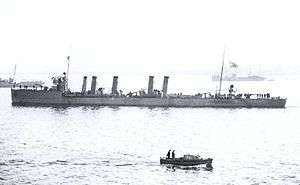Greek destroyer Panthir (1912)
Panthir (Greek: ΒΠ Πάνθηρ, "Panther") was an Aetos-class destroyer which served in the Hellenic Royal Navy from 1912–1946.
 Destroyer Panthir | |
| History | |
|---|---|
| Name: | Panthir (ΒΠ Πάνθηρ) |
| Namesake: | Panther |
| Ordered: | 1912 |
| Builder: | Cammell Laird, Birkenhead |
| Laid down: | 1911 |
| Launched: | 1 April 1911 |
| Commissioned: | 1912 |
| Decommissioned: | 1946 |
| Fate: | broken up |
| General characteristics | |
| Class and type: | Aetos-class destroyer |
| Displacement: | 880 tons standard |
| Length: | 89.4 m (293 ft) |
| Beam: | 8.3 m (27 ft) |
| Draft: | 3 m (9.8 ft) |
| Propulsion: |
|
| Speed: | 31 knots (57 km/h) maximum (32 knots (59 km/h) after 1925) |
| Complement: | 58 |
| Armament: |
|
Origin
The ship, along with her three sister ships Ierax, Leon and Aetos, had originally been ordered by Argentina from the English shipyard Cammell Laird in Birkenhead. Panthir was originally named Santiago del Estero. They were purchased in 1912 by Greece, ready for delivery, each for the sum of £148,000, when the Balkan Wars seemed likely. Accepted by Captain Ath. Miaoulis, RHN in Palermo, Sicily, where she arrived manned by a foreign crew.
Service history
During the Balkan Wars, the Royal Hellenic Navy purchased only the minimum amount of ammunition, 3,000 rounds of torpedoes. Torpedoes were not available for this class of ship, and for this reason these ships were initially named 'scouts' rather than 'destroyers'.
During World War I, Greece belatedly entered the war on the side of the Triple Entente and, due to Greece's neutrality the four Aetos-class ships were seized by the Allies in October 1916, taken over by the French in November, and served in the French Navy from 1917-18. By 1918, they were back on escort duty under Greek colors, mainly in the Aegean Sea.
In 1919-1920, she participated in the operations in Southern Russia evacuating Greek refugees from the Russian Civil War with the battleships Kilkis and Lemnos and the destroyer Leon, remaining for 263 days in the Black Sea. During the Asia Minor war, she took part in the blockade of the Asia Minor coasts.[1]
After the war, Panthir was refurbished from 1925–1927. She also participated in the Second World War, after surviving the German invasion of April, 1941, Panthir was based in the Indian Ocean. Between May and October, 1942, her armament was updated in Bombay enabling her to offer better anti-aircraft protection and anti-surface capabilities on her new missions.
After the end of World War II, Panthir was stricken in 1946.
See also
References
- "HELLENIC NAVY - IERAX D-36 (1912-1946)". Archived from the original on 2011-09-27. Retrieved 2006-10-31.